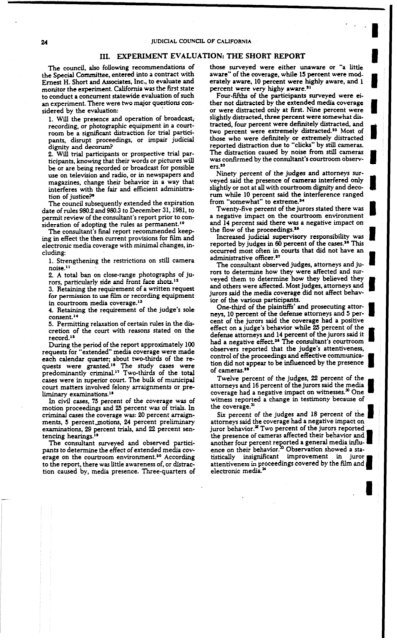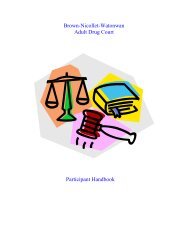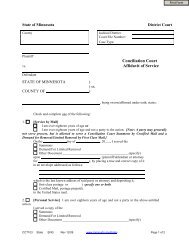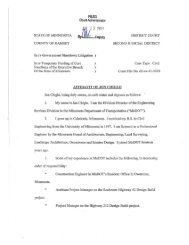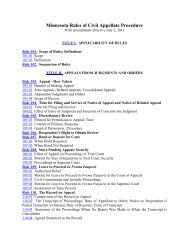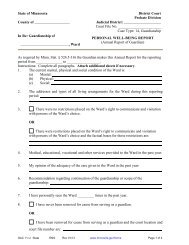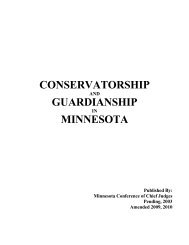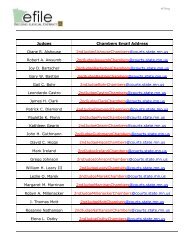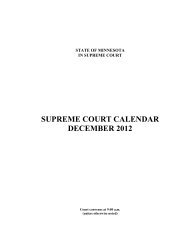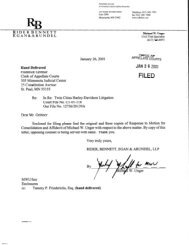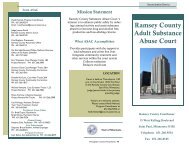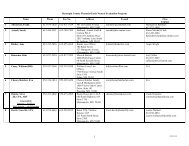1989-03-24 Comments of Star Tribune.pdf - Minnesota Judicial Branch
1989-03-24 Comments of Star Tribune.pdf - Minnesota Judicial Branch
1989-03-24 Comments of Star Tribune.pdf - Minnesota Judicial Branch
You also want an ePaper? Increase the reach of your titles
YUMPU automatically turns print PDFs into web optimized ePapers that Google loves.
<strong>24</strong> JUDICIAL COUNCIL OF CALIFORNIA<br />
III. EXPERIMENT EVALUATION: THE SHORT REPORT<br />
I<br />
The council, also following recommendations <strong>of</strong> those surveyed were either unaware or “a little little<br />
the Special Committee, entered into a contract with aware’* <strong>of</strong> the coverage, coverage, while 15 percent were mod- mod-<br />
Ernest H. Short and hssociates, Inc., to evaluate and erately aware, 10 percent were highly aware, and 1<br />
monitor the experiment. California was the first state percent were very highy aware.‘l<br />
I<br />
to conduct a concurrent statewide evaluation <strong>of</strong> such Four-fifths <strong>of</strong> the participants surveyed were eian<br />
experiment. There were two major questions con- ther not distracted by the extended media coverage<br />
sidered by the evaluation: or were distracted only at first. Nine percent were i<br />
I. Will the presence and operation <strong>of</strong> broadcast; slightly distracted, three percent were somewhat disrecording,<br />
or photographic equipment in a court- tracted, four percent were definitely distracted, and<br />
room be a significant distraction for trial partici- hvo percent were extremely distracted.22 Most <strong>of</strong><br />
pants, disrupt proceedings, or impair judicial those who were definitely or extremely distracted<br />
dignity and decorum?<br />
reported distraction due co “clicks” by &ill cameras.<br />
2. Will trial participants or prospective trial par- The distraction caused by noise from still cameras<br />
ticipants, knowing that their words or pictures w-iIl was confirmed by the consultant’s courtroom observers.a3<br />
I ,<br />
be or are being recorded or broadcast for possible<br />
use on television and radio, or in newspapers and Ninety percent <strong>of</strong> the judges and attorneys surmagazines,<br />
change their behavior in a way that veyed said the presence <strong>of</strong> cameras interfered only<br />
interferes with the fair and efficient administra- slightly or not at all with courtroom dignity and deco- I<br />
tion <strong>of</strong> justice?*<br />
rum while 10 percent said the interference ranged<br />
The council subsequently extended the expiration from “somewhat” to extreme.l*<br />
date <strong>of</strong> rules 980.2 and 980.3 to December X,1981, to Twenty-five percent <strong>of</strong> the jurors stated there was<br />
permit review <strong>of</strong> the consultant’s report prior to con- a negative impact on the courtroom environment I<br />
sideration <strong>of</strong> adopting the rules as permanent.‘O and 14 percent said there was a negative impact on<br />
The consultant’s final report recommended keep the flow <strong>of</strong> the proceedings.as<br />
ing in effect the then current provisions for film and Increased judicial supervisory responsibility was I<br />
electronic media coverage with minimal changes, in- reported by judges in 60 percent <strong>of</strong> the cases.ab This<br />
cluding:<br />
occurred most <strong>of</strong>ten in courts that did not have an<br />
1. Strengthening the restrictions on still camera administrative <strong>of</strong>ficer.”<br />
noise.” . The consultant observed judges, attorneys and ju- I<br />
2. A total ban on close-range photographs <strong>of</strong> ju- rors to determine how they were affected and surrors,<br />
particularly side and front face shots.ll<br />
veyed them to determine how they believed they<br />
3. Retaining the requirement <strong>of</strong> a written request and others were affected. Most judges, attorneys and<br />
jurors said the media coverage did not af!fect behav- I<br />
for permission to use film or recording equipment<br />
in courtroom media coverage.13<br />
ior <strong>of</strong> the various participants.<br />
4. Retaining the requirement <strong>of</strong> the judge’s sole One-third <strong>of</strong> the plaintif%’ and prosecuting attorconsent.”<br />
neys, 10 percent <strong>of</strong> the defense attorneys and 5 per- I<br />
5. Permitting relaxation <strong>of</strong> certain rules in the dis- cent <strong>of</strong> the jurors said the coverage had a positive<br />
cretion <strong>of</strong> the court with reasons stated on the effect on a judge’s behavior while 25 percent <strong>of</strong> the<br />
record.ls<br />
defense attorneys and 14 percent <strong>of</strong> the jurors said it<br />
During the period <strong>of</strong> the report approtiately 100 had a negative effect. lb The consultant’s courtroom I<br />
requests for “extended” media coverage were made observers reported that the judge’s attentiveness,<br />
each calendar quarter; about two-thirds <strong>of</strong> the re-<br />
r<br />
1 _<br />
control <strong>of</strong> the proceedings and effective communica-<br />
quests were granted. lb The study cases were tion did not appear to be influenced by the presence<br />
I<br />
predominantly criminal. If Two-thirds <strong>of</strong> the total <strong>of</strong> camera.sac<br />
cases were in superior court. The bulk <strong>of</strong> municipal Twelve percent <strong>of</strong> the judges, 22 percent <strong>of</strong> the<br />
court matters involved felony arraignments or pre- attorneys and 16 percent <strong>of</strong> the jurors said the media<br />
liminary examinations1 b<br />
coverage had a negative impact on witnesses.= One I<br />
In cjvil cases, 75 percent <strong>of</strong> the coverage was <strong>of</strong> witness reported a change in testimony because <strong>of</strong><br />
motion proceedings and 25 percent was <strong>of</strong> trials. In the coverage.”<br />
criminal cases the coverage was: 20 percent anaign- Sk percent <strong>of</strong> the judges and 18 percent <strong>of</strong> the I<br />
men& 5 percentglotions, <strong>24</strong> percent preliminary attorneys said the coverage had a negative impact on<br />
examinations, 29 percent trials, and 22 percent sen- juror behavior.% Two percent <strong>of</strong> the jurors reported<br />
tencing hearings.10 the presence <strong>of</strong> cameras affected their behavior and<br />
The consultant -eyed and observed partici- another four percent re orted a general media influ- I<br />
pants to determine the effect <strong>of</strong> extended media cov- ence on their behavior. 5: Obsentation showed a sta-<br />
erage on the courtroom environrnent.~O According tistically insignificant improvement in juror<br />
to the report, there was little awareness <strong>of</strong>, or distrac- attentiveness in proceedings covered by the film and<br />
tion caused by, media presence. Three-quarters <strong>of</strong> electronic media.% I<br />
. I’<br />
~


